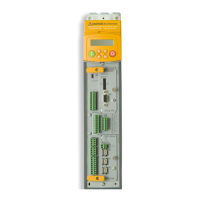Safe Torque Off 6-21
890CS Common Bus Supply - Frames B & D; 890CD Common Bus Drive and 890SD Standalone Drive - Frames E & F
Safety Warnings and Limitations
• Only appropriately qualified professional personnel are permitted to install the STO function and
commission it. They must disseminate and make available all appropriate instructions and documentation
to all personnel who may come into contact with or operate the STO and provide suitable training on the
890 to ensure it is operated in the correct manner and to avoid loss of life, injury or damage.
• The 890 STO function is a factory-fitted and factory-tested feature. It is only compatible with firmware
versions 3.5 and higher. Repairs to 890 STO featured-products are to be carried out only by Parker SSD
Drives. Any unauthorised attempt to use firmware before version 3.5, or to repair or disassemble the
product will render any warranty null and void. Upgrading of non-STO product to STO product is strictly
prohibited. PARKER SSD DRIVES WILL NOT ACCEPT ANY LIABILITY FOR FAILING TO OBEY
THESE INSTRUCTIONS OR FOR ANY CONSEQUENTIAL LOSS OR DAMAGE.
• It is important that the 890 product environment including all aspects of its CE conformance and IP etc.,
specified elsewhere in this manual, is maintained to ensure the safety integrity of the STO function.
• Should synchronous motors be operated in the field weakening range, operation of the STO function may
lead to overspeed and destructive life-threatening overvoltages as well as explosions in the drive.
Therefore, the STO function must NEVER be used with synchronous drives in the field-weakening range.
The user must ensure this condition is prevented.
• When using synchronous permanent magnet motors, shaft movement over a small angle is possible if two
faults occur simultaneously in the power section of the drive. This depends on the number of motor poles.
The maximum angle is:
Rotary motors: 360° / number of poles
Linear motors: 180° electrically.
It is the user’s responsibility to assess, validate and safeguard as necessary against this potential hazard.
• If external forces can act on the motor and/or load to cause it to move, additional measures must be taken
by the user to restrain it, for example mechanical brakes. Examples of external forces are suspended loads
(effect of gravity), and other web-tensioning devices.

